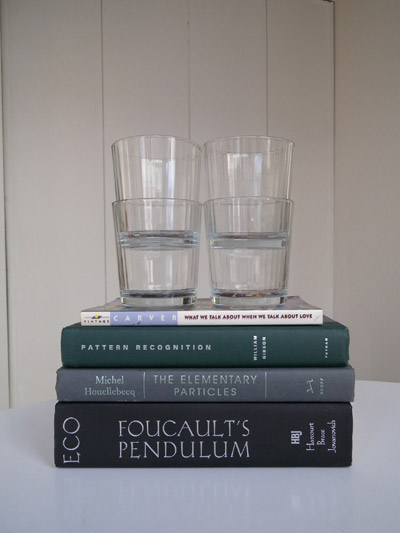HEMAN CHONG: ISLAND (COVER)
| December 1, 2010 | Post In LEAP 6

The latest incarnation of Heman Chong’s work with the lives of books reaffirms him as a straight-talking artist who reserves a place for the personal and the material within the gestures of post-conceptual art. The London-trained Singaporean artist who is represented by Vitamin Creative Space (Guangzhou/Beijing), delves into literature and yet side-steps the prosaic to present new painting and sculpture as concise moments in an extended consideration of human solitude.
Roughly a dozen identically proportioned canvases punctuate the reconfigured walls of Amsterdam’s Motive Gallery in an exhibition plainly titled “Island (Covers).” As imagined paperback covers for a fictive publishing run, the paintings propose images for works of literature such as Paul Auster’s The Music of Chance, Kobo Abe’s Woman in the Dunes and Aldous Huxley’s Island. Each piece addresses the viewer as a self-constituted moment with neoconstructivist shards of tonal color set in impassive conversation with titles and authors of the various stories of selfhood they propose to contain.
Recently relocated to the new cultural district of Amsterdam’s north, Motive is a generous space by Dutch standards. Even with its unheard-of raised ceiling, the gallery was comfortably bustling despite the impressively miserable weather of early winter. Chong’s showing was accompanied by two other parallel, or in the gallery’s terminology “parallax” exhibitions; “Anti” by Dutch photographer Martine Stig and “Itinerary” by French artist Dominique Pettigrand. All three offerings took the single figure, either alone among the multitude or in a more literal isolation as their point of departure.
Here Chong returns to solitude as an idée fixe. Included among the ancillary material of the exhibition is a diagrammatic map of the artist’s associative thoughts around the figure of the “castaway.” The audience is permitted entry to Chong’s mind at the point of his preparation, and is taken through various schemata of scenarios for isolation. In their singularity, Chong’s canvases are wise to the way in which the journeys-to-the-self of their namesake novels are metonymical for the greater social entity, and to the way in which the confined experience of a protagonist often serves as a meta-tale for the collective being of humanity.
Trained in design, Chong’s projects often operate with the artist as a production house. The “Island (Covers)” series is itself an extension of the offset A0 posters that lined the canteen walls of Manifesta 8’s main venue earlier this year, which in turn grew out of the 2006 series “Untitled (Paperback Covers #01).” The application of formula to form is also employed in the two sculptures included within the show. They are points from an annual series in which four books read by the artist over the course of a year are casually stacked along with a set of water glasses used over the same period. These bedside assemblages exude restraint in their ultra-limited editions as the result of a simple set of conceptual terms. In referring to the sculptures, Chong points to the status of both the books and glasses as “vessels.” In a canny move he has created containers that lay bare his influences, presenting objects as indexical to identity.
The social smarts of Chong’s pieces prevent their concern with solitude from being inflicted experientially on the viewer. A recent Western vogue for literature in exhibitions holds sway from Massimilliano Gioni’s 2006 Berlin Biennale titled after Steinbeck’s Of Mice and Men, to Jens Hoffman’s recently completed trio of shows based on classic American novels at the CCA Wattis Institute in San Francisco. In its weaker moments, this turn to narrative supports excessive contrivance and audience manipulation. But in Chong’s exploration of the lone subject there is no solipsism, no cloying attempt to induce the audience into an experience of the novels at hand. Rather, the compression of image and narrative within the canvases and sculptures presents solitude through a self-contained referential complex of objects. Vivian Ziherl


